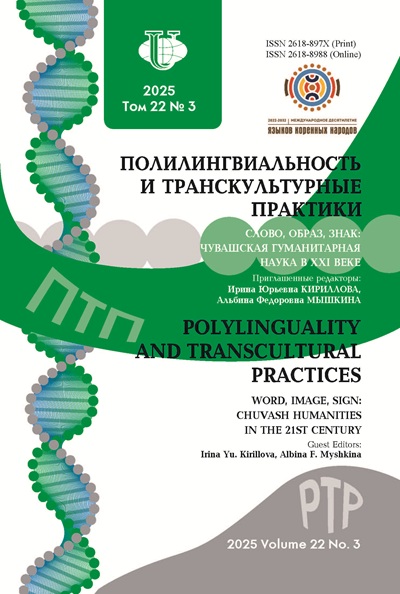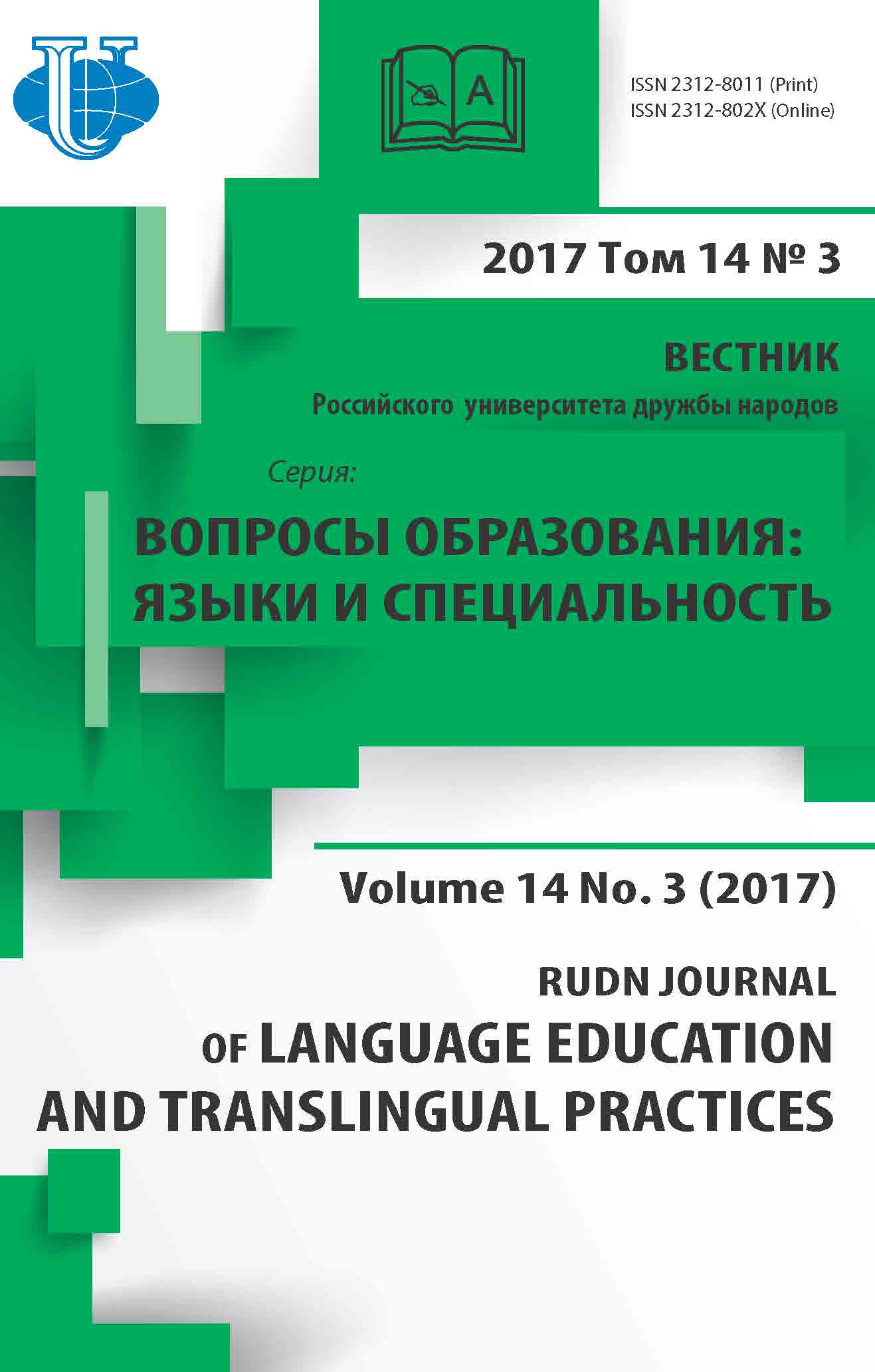ДИГЛОССИЯ СРЕДНЕВЕКОВЫХ ГЛОССАТОРОВ: ЛИНГВОКУЛЬТУРОЛОГИЧЕСКИЙ АНАЛИЗ ДРЕВНЕВЕРХНЕНЕМЕЦКО-ЛАТИНСКИХ ГЛОССАРИЕВ VIII-X вв
- Авторы: Калинин СС1
-
Учреждения:
- Кемеровский государственный университет
- Выпуск: Том 14, № 3 (2017)
- Страницы: 416-422
- Раздел: Языковая личность в полилингвальном аспекте
- URL: https://journals.rudn.ru/polylinguality/article/view/17057
- DOI: https://doi.org/10.22363/2312-8011-2017-14-3-416-422
- ID: 17057
Цитировать
Полный текст
Аннотация
В работе представлен комплексный лингвокультурологический анализ древневерхненемецких глоссариев VIII-X вв. в перспективе двуязычия его авторов. Известно, что основным языком религии, науки и культуры в средневековой Европе являлся латинский язык, который был социально «престижнее». В средневековых немецких государствах древневерхненемецкий, а позднее и средневерхненемецкий языки находились по отношению к нему в подчиненном положении. Представляется интересным то, как языковая ситуация в средневековых германских государствах отражается в письменных памятниках. Материалом исследования служит глоссарий Abrogans (ок. 750 г.), написанный на алеманнском диалекте, Сен-Галленский глоссарий (также ок. 750 г.), который был также написан на алеманнском диалекте, Кассельские глоссы IX в., составленные на баварском диалекте, и Парижская рукопись X в. на средне-франкском диалекте. Эти глоссарии были предназначены как для жителей Германии, владеющих латинским языком, так и для путешественников из романских стран, прибывающих в Германию. На основании анализа текста данных глоссариев и культурной ситуации, отраженной в данных текстах, делается вывод о распространении диглоссии среди средневековых глоссаторов, а также даются лингвокультурологические основы для реконструкции языковой личности средневекового книжника.
Полный текст
1. ВВЕДЕНИЕ Первыми памятниками немецкого языка являются так называемые глоссы - немецкие эквиваленты отдельных латинских слов или высказываний, которые обычно помещались в латинских рукописях на полях или прямо в тексте. Составлялись также особые сборники таких глосс, а также сборники глосс, по своей структуре и прагматике напоминавшие современные разговорники. Сохранилось несколько глоссариев VIII-X вв. Древнейшим из является глоссарий Abrogans или глоссарий Керона (рис. 1), составленный около 750 г. на алеманнском диалекте, он сохранился в трех рукописях, датируемых VIII-IX вв. [1. С. 7]. Примерно к тому же времени относится Сен-Галленский глоссарий VIII в., который также был составлен на алеманнском диалекте (рис. 2). Рис. 1. Страница рукописи глоссария Abrogans [Fig. 1. Some page of the manuscript of Abrogans glossary] Рис. 2. Страница рукописи Сен-Галленского глоссария [Fig. 2. Some page of manuscript of St. Gallen glossary] Имеется также некоторое количество древневерхненемецких разговорниковглоссариев. Наиболее известным из них являются Кассельские глоссы IX в. Они были написаны на баварском диалекте. Их прагматика - помощь путешественнику из романских стран, не знающему немецкого языка, в общении с местным населением Германии [1. С. 48]. Глоссарий-разговорник рассчитан на пользователя, знающего латинский язык. Как и глоссы, разговорник составлен из латинских слов и фраз на древневерхненемецком языке с параллельным переводом на латынь. Еще одним известным разговорником являются Римская и Парижская рукописи X в., составленные на среднефранкском диалекте с элементами нижнефранкского диалекта. Основная часть рукописи этого глоссария находится в Париже, один лист (фразы с 1-й по 42-ю) - в Риме, в Ватиканской библиотеке [1. С. 48]. Вероятно, этот разговорник был предназначен для французского путешественника, не владеющего немецким разговорным языком. В отличие от прочих разговорников в нем вначале дается немецкий текст, а затем следует его латинский перевод. 2. ОБСУЖДЕНИЕ И РЕЗУЛЬТАТЫ Следует сказать несколько слов о том, что такое языковая личность вообще. Языковая личность является совокупностью значимых коммуникативных черт индивида, связанных с порождением и восприятием речи. Связана она и с производством и восприятием языковых произведений (текстов). Языковая личность представляет собой многомерное образование. Согласно Ю.Н. Караулову, одним из важнейших компонентов, входящих в структуру языковой личности, является ее ментальный лексикон, «промежуточный язык» в его терминологии [2. С. 184- 189]. Н.И. Жинкин называет его «языком мозга» [3. С. 18]. Языковая личность, согласно теоретическим выводам В.И. Карасика, может быть охарактеризована с позиции языкового сознания, поскольку именно она является его носителем [4. С. 7]. Языковое сознание же связано с концептосферой языковой личности [4. С. 7-8], поскольку оно является вербальным «отражением во внутреннем мире внешнего мира» [5. С. 24], т.е. оно представляет собой результат процессов концептуализации и категоризации. Основными концептуальными единицами, входящими в состав концептосферы языковой личности, в состав ее «промежуточного языка» (иначе - ментального лексикона), являются, помимо концептов, образы, символы, гештальты, понятия, знаки, фреймы и др. [2. С. 189-210]. Языковую личность как homo loquens, осуществляющего языковую деятельность (languaging) [6. С. 19-20], можно сопоставить с наблюдателем (observer) языковой теории У. Матураны [7. С. 155]. Наблюдатель осуществляет процесс координации координаций языковой деятельности в совместном потоке жизнедеятельности вместе с «созерцаемыми» им живыми существами [6. С. 19-20]. Таким образом, языковая деятельность наблюдателя (языковой личности) представляет собой его адаптацию к окружающей среде. Наблюдатель осуществляет совместный процесс координации координаций языковой деятельности, порождая тем самым языковые, а соответственно, и концептуальные структуры. Таким образом, ментальный лексикон языковой личности («промежуточный язык», «язык мозга» или «язык мысли» в терминологии Ю.Н. Караулова [2. С. 184-189] и Н.И. Жинкина [3. С. 18]) представляет собой структуру, имеющую как экстралингвистический (получаемый на основе информации о координации в совместном потоке жизнедеятельности и информации об окружающей среде), так и нейробиологический (основанный на процессах, происходящих в мозге наблюдателя) субстрат. Соответственно, свойства языковых и концептуальных структур будут являться производными от процесса координации координаций совместной языковой деятельности. С точки зрения языкового учения Й.Л. Вайсгербера ментальный лексикон двуязычной языковой личности представляет собой своеобразный двуязычный «словарь», «культурное достояние» (Kulturgut, в терминологии Вайсгербера [8. С. 77]). Соответствующие компоненты этого словаря активизируются в процессе переключения кодов языковой личностью. Согласно неогумбольдтианскому взгляду на язык языки различного строения (в нашем случае древневерхненемецкий и латинский) предполагают различные способы познания мира [8. С. 139- 140]. Данное положение подтверждается языковыми фактами: ср. калькирование, к примеру, латинских слов clandestinum и abstractum средствами древневерхненемецкого языка в глоссарии Керона - ungalifalih и farzocan соответственно. Вообще следует сказать о том, что немецкий язык на раннем периоде своего развития содержал крайне мало абстрактных и обобщенных понятий. По данным В.М. Жирмунского, «слова с отвлеченным и интеллектуальным значением наличествуют в нем лишь в сравнительно небольшом числе как результат еще примитивной абстракции от основной группы слов с материальным и конкретным значением» [9. С. 302]. Это объясняется различиями в способе концептуализации мира сознанием немецкоязычной и латиноязычной языковых личностей. Как полагает А.А. Залевская, можно говорить о когнитивно-перцептивно-аффективном единстве двуязычной языковой личности [10. С. 14]. И если вопрос о реконструкции аффективного компонента древнегерманской языковой личности выходит за рамки настоящей работы, то различие когнитивных и перцептивных процессов у двуязычной языковой личности можно проследить на материале сохранившихся письменных памятников (в частности, глоссариев) и словарного состава языка. Германское языковое сознание воспринимало мир более конкретно, а абстрактные понятия, как можно убедиться, рассматривая тексты глоссариев, оно моделировало либо на основе средств другого языка (латинского), либо передавало абстрактные понятия через конкретные. Чтобы убедить в этом, достаточно рассмотреть германские мифологические метафоры «мир - это дерево» и «небо - это ткань (покров)», сохранившиеся во внутренней форме слов немецкого языка, в частности. На основании структурного анализа текстов вышеописанных глоссариев можно сделать вывод о том, что языковая личность средневекового глоссатора действительно была преимущественно двуязычной. Следует отметить тот факт, что глоссатор находился в ситуации диглоссии, поскольку латинский язык, как известно, был доминирующим в науке и культуре средневековой Европы, в частности Германии. В.М. Жирмунский пишет о том, что латинский язык в Средние века выполняет все общественно-политические и культурные функции будущих национальных языков, в то же время латынь для средневековой Европы - международный язык преимущественно в письменной форме [9. С. 43]. Национальные языки Европы в ту эпоху были еще недостаточно развиты для отображения всей совокупности научных, религиозных и культурных понятий. Даже такой «богатый» язык, как древнеисландский не мог обойтись без апелляции к латинской книжной культуре и учености (что отражается, в частности, в наличии латиноязычных примечаний в тексте «языческих» по своему содержанию рунических поэм и эвгемерическому описанию происхождения божеств древних скандинавов у Снорри Стурлусона). Тем более эта ситуация естественна для древневерхненемецкого языка, который не имел развитой книжно-письменной традиции. В VIII-X веках немецкий язык не имел единой литературной и письменной нормы и представлял собой, по существу, совокупность территориальных диалектов. Каждый диалект имел свою систему орфографии, свою адаптацию латинского письма к древневерхненемецкому произношению [9. С. 45]. В этой ситуации для средневекового книжника было бы естественным иметь язык-эталон, являющийся более социально и культурно престижным, имеющим давно сложившуюся нормализованную орфографическую систему. Из этого следует, что для средневекового глоссатора билингвизм был естественным. 3. ВЫВОДЫ На основании проведенного исследования можно сделать вывод об особенностях языковой ситуации в средневековой Германии. Данную ситуацию можно охарактеризовать как явление диглоссии, с преимущественным доминированием латинского языка в различных сферах общественной и культурной жизни. В перспективе можно исследовать другие особенности билингвальной языковой личности средневекового глоссатора, особенности ее ментального лексикона. Это может помочь в исследованиях особенностей ментальности средневекового человека.
Об авторах
С С Калинин
Кемеровский государственный университет
Автор, ответственный за переписку.
Email: rage_of_gods@inbox.ru
Калинин Степан Сергеевич - аспирант кафедры лингвистики и переводоведения Института филологии, иностранных языков и медиакоммуникаций Кемеровского государственного университета.
ул. Красная, 6, Кемерово, Россия, 650043Список литературы
- Чемоданов Н.С. Хрестоматия по истории немецкого языка VIII-XVI вв. М.: Издательство литературы на иностранных языках, 1953. 348 с.
- Караулов Ю.Н. Русский язык и языковая личность. Изд. 8-е. М.: ЛИБРОКОМ, 2014. 264 с.
- Жинкин Н.И. Речь как проводник информации. М.: Наука, 1982. 159 с.
- Карасик В.И. Языковой круг: личность, концепты, дискурс. М.: Гнозис, 2004. 390 с.
- Лурия А.Р. Язык и сознание. М.: Издательство Московского университета, 1998. 336 с.
- Maturana H.R. Biology of self-consciousness. Consciousness: Distinction and reflection. Naples, Italy: Bibliopolis, 1995. Pp. 145-175.
- Maturana H.R. Anticipation and self-consciousness: Are these fuction of the brain? Constructivist Foundations. 2008. № 4 (1). Pp. 18-20.
- Вайсгербер Й.Л. Родной язык и формирование духа / пер. с нем.; вступ. ст. и комм. О.А. Радченко. Изд. 3-е. М.: ЛИБРОКОМ, 2009. 232 с.
- Жирмунский В.М. История немецкого языка. Изд. 5-е, пересм. и испр. М.: Высшая школа, 1965. 408 с.
- Залевская А.А. Вопросы психолингвистической теории двуязычия // Вопросы психолингвистики. 2009. № 10. С. 10-17.
Дополнительные файлы














